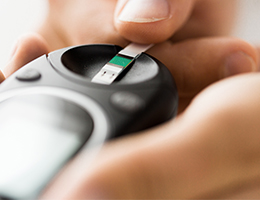
Diabetes is a serious disease. It can harm virtually every part of the body. But treatment can lower the risk for even the worst of its serious health consequences.
Often the tricky part is knowing if you have diabetes—it doesn't always cause symptoms that you'd notice. And that's where testing comes in.
In fact, it's possible that you should be tested for diabetes right now, even if you're feeling fine.
Why get tested?
Having diabetes means your blood sugar (glucose) is above normal, either because your body doesn't make insulin (type 1 diabetes) or doesn't properly make or use it (type 2 diabetes), according to the National Institutes of Health (NIH).
Insulin is a hormone that helps the body convert glucose into energy.
Millions of people have diabetes and don't know it, according to the American Diabetes Association (ADA). It's also possible to have a condition called prediabetes without realizing it. That's when blood sugar is higher than normal but not high enough to be diagnosed as diabetes. Having prediabetes greatly increases your risk for type 2 diabetes.
If you have diabetes, you are at higher risk for many serious health complications. Among them:
- Heart disease.
- Stroke.
- Kidney disease.
- Vision loss.
- Nerve damage.
- Foot problems, such as sores that won't heal.
Learning that you have the disease and taking steps to control it can help you avoid these complications.
And finding and treating prediabetes with diet and exercise may help you avoid type 2 diabetes altogether, according to the NIH.
When to get tested
If you're 45 or older, you should be tested for diabetes. If your test results are normal, you should be tested again at least every three years, according to the American Heart Association.
If you're younger than 45, you should be tested for diabetes if you are overweight and:
- Don't exercise regularly.
- Have an immediate family member with a history of diabetes.
- Are African American, Latino, Native American, Asian American or Pacific Islander.
- Have, or are being treated for, high blood pressure or unhealthy cholesterol levels.
- Have a history of heart or blood vessel disease.
- Have other conditions associated with insulin resistance, such as acanthosis nigricans (a skin condition characterized by a dark, velvety rash around the groin, neck or armpits).
- Have been diagnosed with gestational diabetes.
- Have polycystic ovary syndrome.
Types of tests
There are several different tests your healthcare provider can use to see if you have diabetes or prediabetes. They include:
The fasting plasma glucose (FPG) test, which measures your blood sugar after you have not eaten anything for at least eight hours. It is a simple test that can be used to detect both diabetes and prediabetes.
The test is most accurate when done in the morning, according to the NIH, but it isn't as accurate as some other tests for diabetes. If the results of an FPG test suggest diabetes, a second test is needed on another day to confirm the diagnosis.
The oral glucose tolerance test (OGTT), which measures your blood sugar after you fast for at least eight hours and again two hours after you drink a beverage that contains glucose. According to the NIH, this test is more sensitive than the FPG test for diagnosing prediabetes but more complicated to administer, because it involves measuring your blood sugar immediately before and two hours after drinking the glucose beverage.
Like the FPG test, this test can be used to diagnose both diabetes and prediabetes. Also like the FPG test, a diagnosis of diabetes is only confirmed after a second positive test is done on a separate day.
The A1C test, which measures your average blood sugar control for the past two to three months. Unlike the FPG or OGTT, this test doesn't require fasting. However, it costs more than the other tests. Also, factors such as ethnicity or the presence of blood conditions like anemia can affect the results.
As with other tests, a second A1C test is needed to confirm a diagnosis of diabetes.
Talk to your provider
If you're turning 45 or have other reasons to be concerned about diabetes, talk to your healthcare provider. They can help you decide which test may be right for you.
If one of the above tests shows that you have prediabetes, you should be checked for diabetes every one to two years, according to the ADA.
Reviewed 6/9/2025